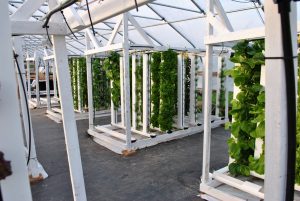5 Innovative Agricultural Practices That Are Changing the World
Digitization in the modern age means that almost every contemporary field or industry is becoming more and more reliant on hardware connected to and, in some cases, controlled by software. These industries are being transformed from the inside out by innovative technology and practices, and even traditionally analogue ways of life are finding it difficult to resist disruption.
Agriculture is a prime example of one of these industries, with the experts at Maryville University actually including it as one of ten “on fire†fields for up-and-coming software developers.
“The agriculture industry has experienced a massive technological shift of late,†they write. “Precision agriculture involves big data, drones, sensors, and farm management software …  Environmental controls, cellular agriculture (micro farms), smart packaging technology, gene manipulation, and e-grocer businesses have also pushed the entire agricultural business world into the computer age.â€
These innovative practices and technologies may very well prove to be more than just the future of farming and agriculture — they may be the very keys to the survival of the human race.
Here are five innovative agricultural practices and technologies that are changing the world.
1. Urban Agriculture, Smart Design, and Vertical Farms
The big advantage that urban farming touts is the innovative reimagining and utilization of space. Urban farms might be as humble as your traditional, outdoor community garden. On the other hand, they might be as complex and futuristic as well-regulated, self-contained, environmentally controlled pods that are stacked on top of each other.

In one of the latest trends in urban farming, vertical farming, we’ve begun to realize yields that are nearly 10 times more efficient than traditional agriculture. “Vertical farming doesn’t promise to radically change the way we farm, only make it more efficient, productive, and take up less space,†writes Jelor Gallego with Futurism.com.
Traditional farmers could take a lesson from vertical farmers in their buildings and design, adopting the tenets of smart design to reduce waste and increase yield. Josh Tittle, writing on smart and sustainable barn design, reminds that it’s easy to get carried away by what you want rather than what you need.
“ … more space means more energy that’s needed for heat and light, which in turn makes for higher costs and more wasted resources. Instead of building a larger structure, consider what it is you need at the moment and design an efficient space for that purpose,†he writes.
As we continue to overpopulate our world and take up space, we’ll need to rely on efficiency in spaces and growth to continue to feed ourselves. Unfortunately, no matter how high we build or how intelligently we design, human beings are causing extensive damage and change to our environments, impacting our ability to raise healthy, mature crops.
2. The Drones & the Bees
Climate change is a massive problem for human beings that, perhaps, hasn’t been fully realized yet — but it’s no secret that we’re on an extremely destructive path.
“If climate change continues to worsen, food shortages could drive prices higher even in more developed countries like the U.S., leading to a public health crisis in the form of global food shortages and waves of hunger,†write the experts at the University of Reno, Nevada in their blog. “As such, public health officials should turn their attention to exploring efforts to shore up food reserves and alternative forms of agriculture.â€
One of the problems that it seems everybody is familiar with is the problem of disappearing bees — Time magazine claims that there are more than 700 species of North American Bee that headed toward extinction. This could spell disaster, as bees “play an important economic role as pollinators helping sustain agricultural production,†they write. “In the United States, that value reaches billions of dollars annually, according to a 2015 White House report.â€
Fortunately, drones are now being used in experiments to, hopefully, supplement the pollination efforts that bees have traditionally completed.
“The Beak & Skiff Apple Orchard in LaFayette has become the first apple orchard in the world to pollinate its trees using a drone, according to the start-up company that developed the technology,†writes Rick Moriarty with Syracuse.com.
Pollination aside, there are plenty of ways that that agriculture could utilize drones, including aerial drone photography for a quick look at fields, automated crop harvest, and even as delivery drones in the future. This will be further compounded by a further rise in automation, A.I., and the IoT.
3. Artificial Intelligence, IoT, and Automation
When we think about the future of driving, we generally think about cars on the road and commuters that aren’t required to keep their hands on the wheel — because A.I. is doing the driving. What we generally don’t think about, however, is driverless vehicles on the farm. Nevertheless, a company called Smart Ag has announced functional driverless tractor technology in the form of “AutoCart†software, according to Matthew J. Grassi with Precision Ag.
“This software application fully automates a grain cart tractor, which provide farmers much needed assistance during the demanding harvest season,†he writes. “Colin Hurd, the founder and CEO of Smart Ag, said the innovative technology will allow farmers to automate their existing equipment and maximize its efficiency and capacity – regardless of manufacturer.”
The AutoCart software is actually a cloud-based platform, meaning that these automated ag vehicles will join the worldwide internet of things (IoT).
Of course, automated vehicles are just one facet of machine learning and IoT innovation in agriculture. Kristin Houser reports that Chinese farmers have recently begun “testing a new AI system that uses a combination of machine vision, voice recognition, and temperature sensors to keep track of pigs’ location, health, and wellbeing.â€
Other use-cases include advanced detection of diseases in crops using many of the same techniques.
It’s important to remember that much of AI’s true potential has yet to even be realized and that the field is still very much in its infancy. A little further along, however, is blockchain technology — the same tech behind the latest financial phenomenon, bitcoin and other cryptocurrencies.
4. Blockchain Technology
While most people know the blockchain for its application in cryptocurrency finance, the agricultural world is beginning to get to know this innovative new technology in another capacity.
Commodity traders Louis Dreyfus Co. (LDC) recently completed the first blockchain-powered agricultural trade, selling and delivering 60,000 tons of soybeans to China in December 2017. This trade represents how the blockchain will likely be used in agriculture early on, with decentralized transactions and self-executing smart contracts.
“Most of the early applications of blockchain in agriculture have to do with traceability and supply chains; a blockchain ledger could record and update the status of crops from planting to harvest to storage to delivery,†writes Remi Schmaltz with AgFunder News. “The upside for large operations is a secure, immutable ledger that ensures you never lose a load. The status of all your crops is available in real time.â€
Another way that the blockchain can be used is for resource management, like tracking machinery maintenance records or for tracking other sensors and equipment.
5. CRISPR and Genetic Editing
Scientists have recently begun utilizing CRISPR/Cas9 to do precise genetic “surgeries,†so-to-speak, allowing them to target and alter the genome of an organism by cutting out or replacing specific parts of a DNA strand’s genetic sequence. Medical News Today reports that genetic editing via this avenue has been shown to lower cholesterol in monkeys, and could be used to eradicate the herpes virus in humans.
Now, CRISPR is being used to change a cow’s gut microbes to try and reduce the amount of methane they are producing as well as how large they get.
“Tweaking cow microbiomes to make more meat on less food could make the meat industry more efficient and more profitable,†writes Chelsea Gohd with Futurism.com. “Given that methane has roughly 25 times the heat trapping ability of carbon dioxide, reducing cows’ methane production could also have a serious impact on the environment.â€
Scientists have also begun engineering crops that require less water and that grow more food. Of course, there could be unforeseen consequences when it comes to messing with genetics in any environment or ecosystem — we’ll have to be extremely cautious that we don’t create more problems in an attempt to solve a few.
These are just a couple of ways that innovative agricultural practices are changing our future, and making the world a more liveable place. Without these innovations, it’s worth mentioning that climate change’s effect on crop growth and the threat of overpopulation could decimate the human race. Innovation in agriculture isn’t just interesting — it’s essential to our survival!
Wait! Before you go…
Choose how you want the latest innovation content delivered to you:
- Daily — RSS Feed — Email — Twitter — Facebook — Linkedin Today
- Weekly — Email Newsletter — Free Magazine — Linkedin Group
 Andrew Heikkila, a tech enthusiast, and writer from Boise, Idaho, and a frequent contributor to Innovation Excellence. He also writes for Tech Crunch. You can follow him @AndyO_TheHammer
Andrew Heikkila, a tech enthusiast, and writer from Boise, Idaho, and a frequent contributor to Innovation Excellence. He also writes for Tech Crunch. You can follow him @AndyO_TheHammer
NEVER MISS ANOTHER NEWSLETTER!
LATEST BLOGS
How Brexit Has Affected UK E-commerce Businesses
Photo by Zyro on Unsplash The popularity of online shopping was already growing at an impressive rate – and…
Read MoreOvercoming range anxiety: three tips for EV owners
Photo by Jenny Ueberberg on Unsplash In the last few years, electric vehicles (EVs) have become more and more…
Read More



Please elaborate further on how drones can take the place of bees?Putting in factor things like pollination,nectar e.t.c.
nice post.Thanks for sharing a blog.This blog is very nice.Your blogs information is real.I hope your blog are provide the real knowledge.agriculture products Manufacturers in Ludhiana Punjab India
Very informative article you’ve shared here. IoT has truly revolutionized the farming industry. It solves the many major problems and helps the farmers to make things or work fast and convenient manner. Many Farming Businesses hire the IoT App Development Company to develop IoT apps that make work systematic and help the farmers to get on-time solutions which save money and time.
It sounds really good. Thanks for the great information. Best Rotavator manufacturers in Ludhiana Punjab
[…] Five innovative farming methods and technologies that are playing a significant role in changing the agricultural sector: […]
[…] Five innovative farming methods and technologies that are playing a significant role in changing the agricultural sector: […]
Excellent stiff on innovative agricultural technologies and practices! I am interested in knowing more about how block chain technology can revolutionize agriculture! Can you send me more materials on this innovation?
It was a very informative and great article, i did not knew a lot about innovations in agriculture. Thank you for writing and educating all the readers who come here.
Hey Disruptor League! Thank you for this great article with a lot of different insights on agriculture and new practices that innovate this industry. I just came across this report, that maybe can help you find more insights on the matter and business opportunities within the field. It focuses on irrigation, farming and agriculture. Maybe you can check it out. https://www.valuer.ai/blog/innovating-sustainability-the-future-of-food-and-agriculture
Keep it Up Really you share great post with informative content to inform about the urban Agriculture, Smart Design, and Vertical Farms. if anyone is seeking for Cattle Feed Machinery, Poultry Feed Machinery,etc. Deal with Vishavkarma Engineering Work known as the leading Cattle Feed Machine Manufacturers in Khanna Punjab
Thanks for sharing this post to inform us of these 5 Innovative Agricultural Practices that changing the world.
Shree Bhawani Agro Industries is one of the leading manufacturer for dealing in Rotavator Parts and Tractor Spare Parts threshers, trolly cultivators, harvester & other agriculture spare parts, etc.
THX THIS HELPED ME WITH MY SCHOOL WORK 🙂
I, too, collect information from your article.